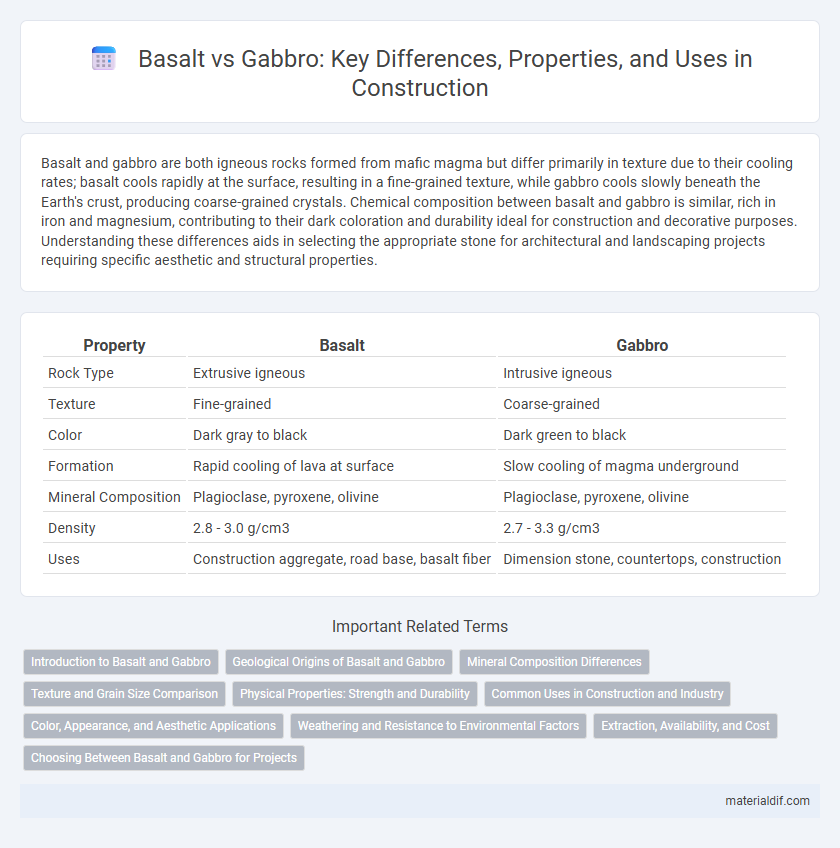Basalt and gabbro are both igneous rocks formed from mafic magma but differ primarily in texture due to their cooling rates; basalt cools rapidly at the surface, resulting in a fine-grained texture, while gabbro cools slowly beneath the Earth's crust, producing coarse-grained crystals. Chemical composition between basalt and gabbro is similar, rich in iron and magnesium, contributing to their dark coloration and durability ideal for construction and decorative purposes. Understanding these differences aids in selecting the appropriate stone for architectural and landscaping projects requiring specific aesthetic and structural properties.
Table of Comparison
| Property | Basalt | Gabbro |
|---|---|---|
| Rock Type | Extrusive igneous | Intrusive igneous |
| Texture | Fine-grained | Coarse-grained |
| Color | Dark gray to black | Dark green to black |
| Formation | Rapid cooling of lava at surface | Slow cooling of magma underground |
| Mineral Composition | Plagioclase, pyroxene, olivine | Plagioclase, pyroxene, olivine |
| Density | 2.8 - 3.0 g/cm3 | 2.7 - 3.3 g/cm3 |
| Uses | Construction aggregate, road base, basalt fiber | Dimension stone, countertops, construction |
Introduction to Basalt and Gabbro
Basalt and gabbro are both mafic igneous rocks formed from the cooling of magma rich in iron and magnesium, but basalt is extrusive while gabbro is intrusive. Basalt cools rapidly on the Earth's surface, resulting in a fine-grained texture, whereas gabbro crystallizes slowly beneath the surface, creating a coarse-grained texture. These differences influence their usage in construction, with basalt favored for road base and gabbro often used as dimension stone.
Geological Origins of Basalt and Gabbro
Basalt and gabbro are both mafic igneous rocks formed from the cooling of magma derived from the Earth's mantle, but their geological origins differ primarily in cooling rate and environment. Basalt forms from rapid cooling of lava at or near the Earth's surface, creating fine-grained crystals, while gabbro crystallizes slowly beneath the surface in intrusive bodies, resulting in coarse-grained textures. Both rocks share a similar chemical composition rich in iron and magnesium, reflecting their mantle-derived magma source.
Mineral Composition Differences
Basalt primarily consists of plagioclase feldspar and pyroxene, with finer-grained crystals due to rapid cooling at the surface, while gabbro contains coarser grains of similar minerals formed from slow crystallization beneath the Earth's crust. The higher calcium content in plagioclase feldspar is typical of both rocks, but gabbro often has more pronounced olivine and amphibole compared to basalt. These mineral composition differences influence the texture and density, making gabbro more coarse-grained and denser than basalt.
Texture and Grain Size Comparison
Basalt features a fine-grained, aphanitic texture due to rapid cooling of lava at the Earth's surface, resulting in crystals usually less than 1 millimeter in size. Gabbro exhibits a coarse-grained, phaneritic texture formed from slow cooling of magma beneath the crust, with visible crystals typically larger than 1 millimeter. This contrast in texture and grain size distinguishes basalt's volcanic origin from gabbro's plutonic formation.
Physical Properties: Strength and Durability
Basalt exhibits higher density and fine-grained texture, resulting in exceptional compressive strength and resistance to weathering, ideal for construction and pavements. Gabbro, with its coarser grain and slightly lower density, offers robustness and durability suitable for heavy structural applications but may be more prone to fracturing under stress. Both igneous rocks provide durable options, with basalt favored for wear resistance and gabbro for load-bearing strength in architectural projects.
Common Uses in Construction and Industry
Basalt is widely used in construction for road base, concrete aggregate, and asphalt pavement due to its durability and high compressive strength. Gabbro finds common applications as dimension stone in building facades, monuments, and countertops because of its coarse-grained texture and aesthetic appeal. Both stones serve critical roles in industrial processes, with basalt also utilized in insulation products and gabbro in crushed stone for railroad ballast.
Color, Appearance, and Aesthetic Applications
Basalt typically exhibits a fine-grained texture with a dark gray to black color, often providing a smooth, uniform appearance ideal for contemporary architectural projects and exterior cladding. Gabbro, coarser and more granular, features a wider color range including dark green, black, and speckled patterns, making it suitable for decorative stonework and countertops that require durable yet visually striking surfaces. Both stones offer distinct aesthetic applications, with basalt favored for sleek, modern designs and gabbro prized for its textured elegance and variety in interior design.
Weathering and Resistance to Environmental Factors
Basalt exhibits higher resistance to weathering due to its fine-grained texture and rapid cooling, which results in a dense, compact structure less permeable to water and air. Gabbro, with its coarse-grained composition, is more susceptible to chemical weathering as larger mineral grains facilitate faster breakdown by environmental factors like moisture and temperature fluctuations. Both igneous rocks withstand physical weathering well, but basalt's durability makes it preferable for constructions exposed to harsh climates and erosive conditions.
Extraction, Availability, and Cost
Basalt is an extrusive igneous rock commonly extracted from surface quarries, offering high availability due to extensive volcanic regions worldwide, leading to lower transportation and extraction costs. Gabbro, an intrusive igneous rock formed deep within the Earth's crust, requires more intensive mining techniques and has limited surface exposure, resulting in higher extraction complexity and cost. The widespread abundance of basalt combined with simpler extraction processes typically makes it more cost-effective than gabbro for construction and industrial uses.
Choosing Between Basalt and Gabbro for Projects
Basalt offers a fine-grained texture and high durability, making it ideal for exterior paving and construction where weather resistance is crucial. Gabbro's coarse-grained structure provides a more polished aesthetic, preferred for interior countertops and decorative applications requiring a robust, visually striking surface. Project requirements such as exposure conditions, desired finish, and budget should guide the choice between basalt and gabbro.
Basalt vs Gabbro Infographic

 materialdif.com
materialdif.com